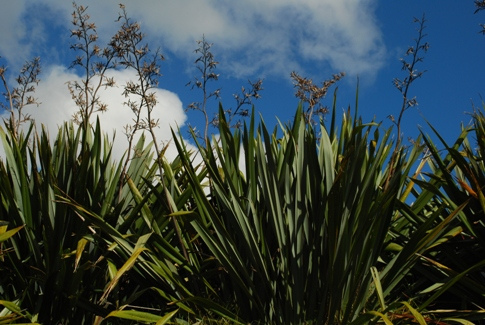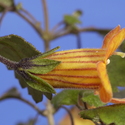Māori have many traditional uses for harakeke1 (Phormium tenax) such as the making of traps and fishing nets and the weaving of whāriki (mats) and kete (baskets). Harakeke is also important for the production of textiles, for example, muka2, a prepared flax fibre, is frequently used as the base for kākahu (clothing) or korowai (cloaks).
Rangi Te Kanawa (Ngāti Maniapoto), a textile conservator at The Museum of New Zealand Te Papa Tongarewa, faced the problem of rapid deterioration in the harakeke kākahu. Of particular concern was the rapid deterioration of the fibres that had been dyed black using a traditional method where the fibre is immersed in paru (mud).
Te Papa has the largest collection of Māori textiles in the world. Amongst these important taonga3 are 400 kākahu, and most utilise a muka backing with feathers, dog skin and other decorations woven into the front of the kākahu.
For Māori today, these textile taonga are not only a living connection to their ancestors, they’re also a rich repository of knowledge about crafting and weaving techniques.
Te whāinga – the goal
Rangi needed to find a way to prevent the deterioration in order to protect these precious taonga tuku iho4 and their valuable intellectual property5 for future generations.
Rangi teamed up with Dr Gerald Smith, Associate Professor of Chemistry at Victoria University. Gerald specialises in the chemical and physical processes responsible for the degradation of organic6 materials and teaches a course in heritage material science.
Rangi, who comes from a long line of weavers, brought specialised mātauranga7 (knowledge) accumulated over generations within her whānau8. Rangi and Gerald used their combined knowledge to identify what was responsible for the deterioration of the textiles and how they might work to counteract it.
When I began my training as a conservator, I realised then that there was a problem – a problem that I’d been witness to as a child, watching mum and nana put this fibre muka into mud.
Rangi Te Kanawa, textile conservator, Te Papa
Rangi and Gerald’s work was able to identify the chemical reactions causing the damage – the breakdown of acetic acid9 produced by the harakeke that, when released, further accelerated the disintegration of the textile. The black dyed fibre was significantly more vulnerable because the dying process introduces tannins in the paru.
Solution
Having determined the key cause of the damage to the textiles, Rangi and Gerald began to research a possible solution to either neutralise or reduce the acetic acid.
Rangi came up with a novel10 solution using alginate11 from seaweed. Gerald was able to test this by accelerating the deterioration of fibres in an oven. The fibres that were pre-treated with the solution – and those that weren’t - were then tested using a gas chromatograph12. This showed that the alginate solution neutralised the acetic acid.
Gas chromatograph
An important tool in Gerald’s lab is the gas chromatograph.
Atmospheric chemist13 Dr Katja Riedel also uses a gas chromatograph. In the above video she explains how it works.
Rangi is now using the innovative alginate solution in her work conserving the kākahu at Te Papa.
Other indigenous14 cultures also use chemically-identical dying methods, and the solution is now being used by conservators around the world.
A kaupapa Māori approach to harakeke research
Dr Bronwyn Lowe at Otago University worked with Māori weavers to investigate a collection of harakeke plants at the Dunedin Botanic Garden.
Because of the cultural significance of harakeke, the research on the collection was done using a kaupapa Māori15 approach. This meant that the involvement of Māori weavers Kahutoi Te Kanawa, Roka Ngarimu-Cameron, Anna Gorham and Christine Holtham was paramount. The weavers chose which harakeke plants would be studied in detail and assessed the weaving properties of each one. The weavers also worked with their people to make decisions about how the results would be disseminated. Read more about this research in this article, Harakeke under the microscope.
Rongoā
Harakeke has many medicinal uses that have been passed down to modern Māori from their tāpuna (ancestors). Read more about rongoā16 and medicinal native17 plants, in this article, Rongoā Māori.
High school student Chris Ryan researched the medicinal properties of kawakawa, read about it in this Connected journal article.
Using rongoā Māori is an activity for students learn about rongoā Māori through a silent card game.
Explore our collection of Rongoā Māori resources on the Science Learning Hub with helpful notes for teachers. Login to make this collection part of your private collection – just click on the copy icon18. You can then add additional content, notes and make other changes.
Nature of science
Using science to understand problems and find solutions often leads to innovative discoveries and technologies. Combining knowledge of historic practices with new scientific understanding gives us insights into why these historic practices worked and how to use and enhance them today.
Related content
Black is back is an Connected journal article featuring Dr Rangi Te Kanawa, and has supporting teacher resources, from the Ministry of Education’s Connected series.
Useful links
Te Papa’s kākahu researchers – Learn more about Dr Rangi Te Kanawa and her fellow kākahu researchers Hokimate Harwood and Dr Patricia Wallace at Te Papa.
Listen to this Radio NZ programme Dr Rangi Te Kanawa: working to conserve our taonga kakahu from May 2022.
Watch this Te Papa video on YouTube of Rangi talking about her work and how her upbringing influenced her work in conserving the Māori cloaks in Te Papa's collection.
In the video, ethnobotanist Sue Scheele and kaitiaki19 Katarina Tawiri show some of the flaxes and their different properties. Harakeke samples for this research came from a collection of traditional weaving varieties of harakeke at Manaaki Whenua20 – Landcare Research. Explore the different harakeke in the National New Zealand Flax Collection and learn more about them.
Project Mātauranga
Watch Series 2/Episode 1: The Problem with Harakeke
Project Mātauranga is a television series that investigates Māori world views and methodologies within the scientific community21 and looks at their practical application. Each of the 13 episodes in series 2 shows how western science and Māori knowledge systems are combining to provide solutions to a variety of challenges.
The Science Learning Hub thanks Scottie Productions for allowing us to host these videos.
- harakeke: New Zealand flax (Phormium tenax).
- muka: Prepared fibre of harakeke (flax).
- taonga: Within the Māori world view, a taonga is a treasure that represents whakapapa in relation to a kin group’s estate and tribal resources. Amongst many things, a taonga can be a living creature, a landscape, an object or a song. Taonga are important to the mana (honour and prestige) of the iwi associated with them.
- taonga tuku iho: Heirlooms, treasures that have been handed down.
- intellectual property (IP): An idea or invention that is protected by law, such as a patent, copyright or trademark.
- organic: 1. Molecules that contain carbon and that have a biological origin. 2. Grown using natural processes with nutrients from natural sources.
- mātauranga: Māori cultural knowledge and understanding of the world; Māori wisdom.
- whānau: Extended family.
- acid: A hydrogen-containing substance that is capable of donating a hydrogen ion to another substance.
- novel: New or unusual in an interesting way.
- alginate: A gelatinous (jelly-like) compound extracted from seaweed used as a gelling agent in foods, textile printing and pharmaceuticals.
- gas chromatograph: A laboratory instrument used to separate and analyse chemicals in a sample.
- chemist: A scientist trained in the science of chemistry. Chemists study the composition of matter and its properties.
- indigenous: Originating and living or occurring naturally in an area or environment. People who are the original inhabitants of an area, or their descendants.
- kaupapa Māori: Generally refers to a foundation of understanding and knowledge created by Māori that expresses Māori aspirations, values and principles.
- rongoā: Traditional Māori medicine.
- native: A species that lives naturally in a country, as opposed to species that have been introduced by the activity of humans.
- icon: Representative symbol.
- kaitiaki: A person, group or being that acts as a carer, guardian, protector and conserver.
- whenua: Land.
- scientific community: The total body of scientists, their relationships and interactions.







